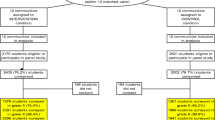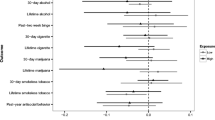Abstract
We undertook the first broad-scale quasi-experimental evaluation of youth outcomes in communities using the Communities That Care program (Hawkins, J. D., & Catalano, R. F., Jr. San Francisco, CA, USA: Jossey-Bass Inc, Publishers, 1992a), which targets adolescent problem behaviors. We evaluated 15 risk factors and 6 outcomes (substance use and delinquent behaviors) for 38,107 youth in 2001 and 98,436 youth in 2003 in Pennsylvania schools. Multilevel analyses compared student reports in communities with CTC programs to comparable communities without CTC, while controlling for level of poverty in the community. Results favored the CTC communities at greater than chance levels in terms of lower rates of some risk factors and outcomes. In a follow-up analysis, CTC community grade cohorts were included only if the grade cohort was expected to benefit from a CTC sponsored program (based on timing of program implementation and target age of the program). Evidence of CTC effects for grade cohorts that received evidence-based programs was even stronger. These findings suggest that community coalitions can affect adolescent public health problems at a population level, especially when evidence-based programs are utilized.
Similar content being viewed by others
References
Arthur, M. W., Hawkins, J. D., Pollard, J. A., Catalano, R. F., & Baglioni, A. J., Jr. (2002). Measuring risk and protective factors for substance use, delinquency, and other adolescent problem behaviors: The Communities That Care Youth Survey. Evaluation Review, 26, 575–601.
COMMIT. (1995). Community intervention trial for smoking cessation (COMMIT): I. Cohort results from a four-year community intervention. American Journal of Public Health, 85(2), 183–192.
Cowen, E. L. (1978). Some problems in community program evaluation research. Journal of Consulting and Clinical Psychology, 46, 792–805.
Farrington, D. P. (1997). Evaluating a community crime prevention program. Evaluation, 3, 157–173.
Feinberg, M. E., Greenberg, M. T., & Osgood, D. W. (2004a). Readiness, functioning, and perceived effectiveness of community prevention coalitions: A study of Communities That Care. American Journal of Community Psychology, 33, 163–176.
Feinberg, M. E., Greenberg, M. T., & Osgood, D. W. (2004b). Technical assistance in prevention programs: Correlates of perceived need in Communities That Care. Evaluation and Program Planning, 27, 263–274.
Feinberg, M. E., Greenberg, M. T., Osgood, D. W., Anderson, A., & Babinski, L. (2002). The effects of training community leaders in prevention science: Communities That Care in Pennsylvania. Evaluation and Program Planning, 25, 245–259.
Glaser, R. R., Van Horn, M. L., Arthur, M. W., Hawkins, J. D., & Catalano, R. F. (2005). Measurement properties of the Communities That Care youth survey across demographic groups. Journal of Quantitative Criminology, 21, 73–102.
Gomez, B. J., Greenberg, M. T., & Feinberg, M. E. (2005). Sustainability of prevention coalitions. Prevention Science, 6, 199–202.
Hallfors, D., Hyunsan, C., Livert, D., & Kadushin, C. (2002). Fighting back against substance abuse: Are community coalitions winning? American Journal of Preventive Medicine, 23, 237–245.
Harachi, T. W., Ayers, C. D., Hawkins, J. D., Catalano, R. F., & Cushing, J. (1996). Empowering communities to prevent adolescent substance abuse: Process evaluation results from a risk- and protection-focused community mobilization effort. The Journal of Primary Prevention, 16, 234–254.
Hawkins, J. D., & Catalano, R. F., Jr. (1992a). Communities That Care: Action for drug abuse prevention. San Francisco, CA, USA: Jossey-Bass.
Hawkins, J. D., & Catalano, R. F., Jr. (1992b). Communities That Care: Action for drug abuse prevention. San Francisco, CA, USA: Jossey-Bass.
Hawkins, J. D., Catalano, R. F., & Miller, J. Y. (1992). Risk and protective factors for alcohol and other drug problems in adolescence and early adulthood: Implications for substance abuse prevention. Psychological Bulletin, 112, 64–105.
Hawkins, J. D., Van Horn, M. L., & Arthur, M. W. (2004). Community variation in risk and protective factors and substance use outcomes. Prevention Science, 5, 213–220.
Hollister, R. G., & Hill, J. (1995). Problems in the evaluation of community-wide initiatives. In J. P. Connell, A. C. Kubisch, L. B. Schorr & C. H. Weiss (Eds.), New approaches to evaluating community initiatives: Concepts. methods, and contexts (pp. 127–172). Washington, DC: The Aspen Institute.
Klerman, L. V., Santelli, J. S., & Klein, J. D. (2005). So what have we learned? The Editors’ comments on the coalition approach to teen pregnancy. Journal of Adolescent Health, 37, S115–S118.
Mittelmark, M. B., Luepker, R. V., Jacobs, D. R. J., Bracht, N., Carlaw, R. W., Crow, R. S., et al. (1986). Commmunity-wide prevention of cardiovascular disease: Education strategies for the Minnesota heart health program. Preventive Medicine, 15, 1–17.
Puska, P., Salonen, J. T., Tuomilehto, J., Nissinen, A., & Kottke, T. E. (1983). Evaluating community-based preventive cardiovascular programs: Problems and experiences from the North Karelia Project. Journal of Community Health, 9, 49–64.
Quinby, R. K., Fagan, A. A., Hanson, K., Brooke-Weiss, B., Arthur, M. W., & Hawkins, J. D. (2007). Installing the Communities That Care prevention system: Implementation progress and fidelity in a randomized controlled trial. Journal of Community Psychology (in press).
Riggs, N. R., Feinberg, M. E., Greenberg, M. T., & Osgood, D. W. (2001). Positional and gender differences among community prevention leaders. Journal of Community Psychology, 30, 709–721.
Rindskopf, D., & Saxe, L. (1998). Zero effects in substance abuse programs: Avoiding false positives and false negatives in the evaluation of community-based programs. Evaluation Review, 22, 78–94.
Roussos, S. T., & Fawcett, S. B. (2000). A review of collaborative partnerships as a strategy for improving community health. Annual Review of Public Health, 21, 369–402.
Saxe, L., Reber, E., Hallfors, D., Kadushin, C., Jones, D., Rindskopf, D., et al. (1997). Think globally, act locally: Assessing the impact of community-based substance abuse prevention. Evaluation and Program Planning, 20, 357–366.
Shadish, W. R., Cook, T. D., & Campbell, D. T. (2002). Experimental and quasi-experimental designs for generalized causal inference. Boston: Houghton-Mifflin.
Spoth, R., Greenberg, M., Bierman, K., & Redmond, C. (2004). PROSPER community-university partnership model for public education systems: Capacity-building for evidence-based, competence-building prevention. Prevention Science, 5, 31–39.
Spoth, R., Redmond, C., Shin, C., Greenberg, M., Clair, S., & Feinberg, M. (2007). Substance use outcomes at 1-1/2 years past baseline from the PROSPER community–university partnership trial. American Journal of Preventive Medicine (in press).
Wagenaar, A. C. (2000). Communities mobilizing for change on alcohol (CMCA): Effects of a randomized trial on arrests and traffic crashes. Addiction, 95, 209–217.
Yin, R. K., & Kaftarian, S. J. (1997). Introduction: Challenges of community-based program outcome evaluations. Evaluation and Program Planning, 20, 293–297.
Acknowledgements
This research is supported by a grant from the Pennsylvania Commission for Crime and Delinquency (PCCD). However, findings and recommendations herein are those of the authors and not official statements of PCCD. We want to acknowledge the enthusiastic support of Michael Pennington, Ruth Williams, Douglas Hoffman, Raymond Moneta, and Clay R. Yeager at PCCD in supporting the vision of this project. We are also grateful for the work of Jonathan Olson in the early analyses of this data, and the consultation of Mike Rovine and David Wagstaff.
Author information
Authors and Affiliations
Corresponding author
Rights and permissions
About this article
Cite this article
Feinberg, M.E., Greenberg, M.T., Osgood, D.W. et al. Effects of the Communities That Care Model in Pennsylvania on Youth Risk and Problem Behaviors. Prev Sci 8, 261–270 (2007). https://doi.org/10.1007/s11121-007-0073-6
Received:
Accepted:
Published:
Issue Date:
DOI: https://doi.org/10.1007/s11121-007-0073-6




